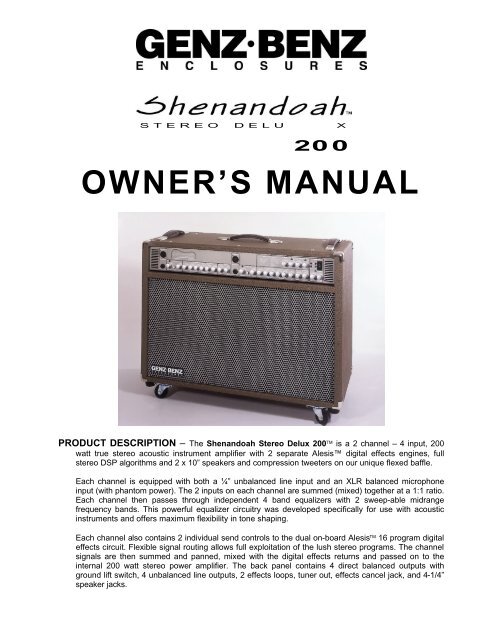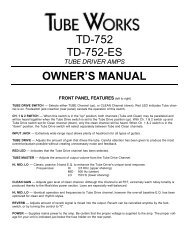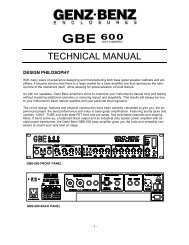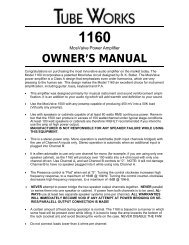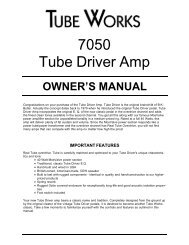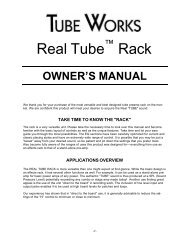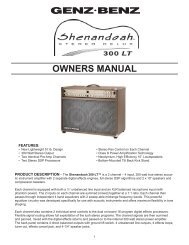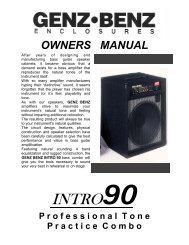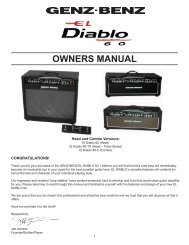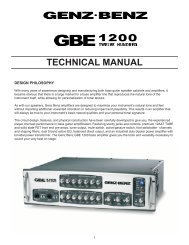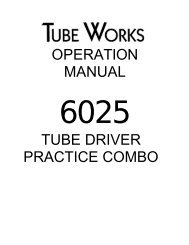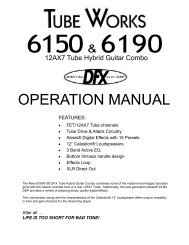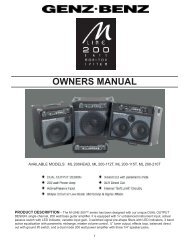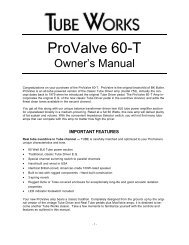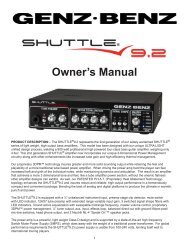Shenandoah 200 Technical Manual - Genz Benz
Shenandoah 200 Technical Manual - Genz Benz
Shenandoah 200 Technical Manual - Genz Benz
Create successful ePaper yourself
Turn your PDF publications into a flip-book with our unique Google optimized e-Paper software.
STEREO DELU<br />
X<br />
<strong>200</strong><br />
OWNER’S MANUAL<br />
PRODUCT DESCRIPTION – The <strong>Shenandoah</strong> Stereo Delux <strong>200</strong> is a 2 channel – 4 input, <strong>200</strong><br />
watt true stereo acoustic instrument amplifier with 2 separate Alesis digital effects engines, full<br />
stereo DSP algorithms and 2 x 10” speakers and compression tweeters on our unique flexed baffle.<br />
Each channel is equipped with both a ¼” unbalanced line input and an XLR balanced microphone<br />
input (with phantom power). The 2 inputs on each channel are summed (mixed) together at a 1:1 ratio.<br />
Each channel then passes through independent 4 band equalizers with 2 sweep-able midrange<br />
frequency bands. This powerful equalizer circuitry was developed specifically for use with acoustic<br />
instruments and offers maximum flexibility in tone shaping.<br />
Each channel also contains 2 individual send controls to the dual on-board Alesis 16 program digital<br />
effects circuit. Flexible signal routing allows full exploitation of the lush stereo programs. The channel<br />
signals are then summed and panned, mixed with the digital effects returns and passed on to the<br />
internal <strong>200</strong> watt stereo power amplifier. The back panel contains 4 direct balanced outputs with<br />
ground lift switch, 4 unbalanced line outputs, 2 effects loops, tuner out, effects cancel jack, and 4-1/4”<br />
speaker jacks.
INPUTS – The <strong>Shenandoah</strong> <strong>200</strong> is equipped with 2 types of input jacks. The ¼” input is unbalanced<br />
and “line/instrument level” with a useable sensitivity from 50 mV to 1 volt. The input impedance is 150<br />
k ohms. The ¼” input will also accept most active balanced line sources, automatically unbalancing<br />
them by recognizing the tip portion of the balanced signal. Additionally, the precision input scaling<br />
preamp contains a 45 Hz, 12 dB/octave high pass filter (more effective and less intrusive than the<br />
more common 6 dB filters) and an “RFI” filter (radio frequency interference) to eliminate unwanted<br />
noise. The XLR input jack is balanced and “microphone level”, with a useable sensitivity from –60dBv<br />
to –30 dBv. It contains a precision full range differential microphone preamp with phantom power. For<br />
use with higher level sources (such as the balanced line level output from a keyboard), a balanced<br />
pad network will be necessary to use the balanced input. Phantom power is 13.6 volts, compatible<br />
with virtually all commonly used condenser microphones. Dynamic microphones can be used with no<br />
ill effect.<br />
PREAMP GAIN CONTROL – This level control sets the amount of gain at the Input of the Preamp.<br />
Use this control to set the input level in conjunction with the overload LED indicator.<br />
INPUT O/L LED – The Red Overload LED senses the input signal to the preamp section and warns of<br />
input overload. For the cleanest signal possible this LED should only flash with the strongest signal<br />
peaks. Adjust this sensitivity with the input gain control.<br />
PHASE SWITCH – Each input is provided with a phase reverse switch. By reversing the phase of the<br />
input signal, feedback tendencies can be reduced if caused by sympathetic vibrations between the<br />
speaker and the instrument. Under some conditions, changing the phase can drastically improve the<br />
output from the amplifier and can improve the playability of some instruments.<br />
PAN CONTROL – Each input channel is provided with a pan control, which adjusts the balance of the<br />
input signal between the left and right output amplifiers. This control does not affect the assignment of<br />
the effects send signals.<br />
COMBINING XLR & ¼” INPUTS – A unique feature of the <strong>Shenandoah</strong> <strong>200</strong> is the ability to mix<br />
the XLR balanced and ¼” unbalanced inputs on each channel. In many situations, this effectively<br />
makes the amplifier function as a 4 channel amplifier. The most effective way to use this feature is to<br />
set the volume on the channel using the XLR microphone input and then adjusting the level control on<br />
the instrument itself (assuming that it has one) to blend levels between the 2 inputs. Equalization will<br />
be common to both inputs on the channel.<br />
ON-BOARD ALESIS STEREO DIGITAL EFFECTS – The <strong>Shenandoah</strong> <strong>200</strong> contains 2<br />
genuine Alesis 16 program stereo digital effects processors. Unlike other amplifier manufacturer’s<br />
built-in digital effect units, we chose to use an industry leader in processing with an undisputed<br />
reputation for realistic, high quality stereo effects algorithms. Not all effects will be suitable for all<br />
types of instruments or playing styles, but everyone should find a good selection of solid, useable<br />
programs. Just keep in mind that a program that doesn’t work well for your quick acoustic guitar or<br />
mandolin work (long lush reverbs for example) may be the perfect program for jazz guitar, sax or<br />
flute. To accommodate the wide range of sum & difference effects in the stereo decay envelope<br />
software, effects volume differences are normal when switching between different effects programs.<br />
Adjust the effects send and master levels accordingly.<br />
One of the most powerful features of the Alesis DSP engine is its ability to process a large amount<br />
of audio data in real-time. This allows us to take advantage of several important concepts in<br />
generating a believable stereo image. By delaying a portion of the signal by an “early reflection ratio”,<br />
applying DSP processing in stereo to this signal, then summing it back with the original signal and<br />
returning the mix to the program bus, the resulting stereo image is big, lush and exceptionally stable.<br />
The “Effects Send A” control on each channel adjusts the send level to digital effects processor “A”<br />
and the “Effects Send B” control on each channel adjusts the send level to digital effects processor<br />
“B”. The “Digital Effects Level” control in the master section adjusts the effects return level from the<br />
corresponding processor. The effects return signals are summed and routed directly to the left and<br />
right amplifiers.<br />
A ¼” TRS effects cancel jack is provided on the back panel to mute the internal effects via footswitch.<br />
Any standard 2 button latching footswitch may be used. Ring controls Effects Return A and Tip
controls Effects Return B. The effects signal is muted when the switch is open. LED’s show when the<br />
effects are active.
ACTIVE 4 BAND EQUALIZATION – Each channel of the <strong>Shenandoah</strong> <strong>200</strong> contains a separate 4<br />
band (with 2 sweepable mids) active equalizer. These equalizers, similar to those found on<br />
professional sound consoles, are very useful tools when used correctly.<br />
LOW FREQUENCY EQ - The corner frequency of the low frequency section is 85 Hz, with a shelving<br />
curve type. This frequency is particularly handy when dealing with low frequency feedback from a big<br />
dreadnaught guitar, cello or upright bass. With a “boomy” instrument on a small stage, a combination<br />
of volume reduction and turning down the low frequency control will generally get good results. The<br />
low frequency control is also handy for adding some “bottom” to a baritone sax and “chunk” to many<br />
stringed instruments.<br />
HIGH FREQUENCY EQ - The corner frequency of the high frequency section is 8 kHz, shelving curve<br />
type. This frequency is especially useful for taming the bright harshness of some mandolins, violins,<br />
brass and reeds. It can also be used to help acoustic guitars, cellos and flutes cut through other<br />
players in loud club situations, or where drums are present.<br />
MIDRANGE EQ - The “sweep mid” section features 2 independent midrange equalizers, peaking<br />
curve type, with over 12 dB of cut or boost and a bandwidth approximately 1 octave wide. The center<br />
frequencies of these equalization filters are continuously user adjustable from 100 Hz to 1.8kHz (LOW<br />
MID) and 350 Hz to 5 kHz (HIGH MID) with the corresponding frequency control. These filters are<br />
typically (but not always) used to reduce or remove offending frequencies in the instrument’s pick-up<br />
response. Removing only the minimum amount necessary will yield the most acoustically rewarding<br />
results. The easiest and most repeatable way to determine the offending frequency range is to boost<br />
the mid level somewhat (but not to the point of feedback) and while playing, sweep the frequency<br />
control slowly across its range. You may need a third hand until it becomes second nature, but soon<br />
you will find out just how quick it can be. You will hear a clear and obvious accentuation of the<br />
“ugliness” you wish to remove. Then, reduce the gain control until the sound you desire is attained.<br />
The ear is a most sensitive and discriminating piece of test equipment when used in this manner,<br />
another good reason to protect them! This is the way many touring sound engineers equalize, since it<br />
is quick, accurate and repeatable. Occasionally, you will find need to use the mid section in “boost”<br />
mode, particularly common when adding higher midrange (bite) to an otherwise dull instrument, or<br />
adding low mid “body” to an otherwise thin sound. Spend some time experimenting so that the<br />
process becomes creative as well as corrective.<br />
AUXILUARY INPUT LEVEL CONTROL – The <strong>Shenandoah</strong> <strong>200</strong> is equipped with both ¼” and<br />
dual RCA aux input jacks and aux level control. These rear panel jacks are internally summed, and<br />
feed the stereo mix via the aux level control. Both aux inputs are line level, for use with drum<br />
machines, CD, MP3 and tape players.<br />
MASTER VOLUME – The stereo master volume control adjusts the overall volume of the mix of<br />
channel 1, channel 2, effects return 1 and effects return 2. Typically, best results are obtained when<br />
this control is operated between the 9:00 and 3:00 positions.<br />
MASTER STATUS LED INDICATORS - Output status LED’s are provided to indicate Signal<br />
present and Clipping. The Green LED monitors the pre Master Volume output signal from the preamp<br />
before the power amp section. The Red LED indicates Clip/Limit and indicates that the maximum<br />
power threshold has been crossed and the internal “soft-clip” limiter is active. Driving the amp 6db<br />
beyond this point will cause gradual clipping.<br />
CHANNEL INSERTS / EFFECTS LOOP – The <strong>Shenandoah</strong> <strong>200</strong> is equipped with insert points<br />
on each channel AND on the left and right main signal paths. These points are handy for inserting<br />
compressors and dedicated digital effects processors. Signal is line level and unbalanced.
DIRECT OUTPUTS – The <strong>Shenandoah</strong> <strong>200</strong> contains the most comprehensive direct output section<br />
available on any acoustic instrument amplifier. The XLR balanced and ¼” unbalanced outputs make<br />
“real world sense” when connecting with other equipment. The ¼” unbalanced outputs are true<br />
professional line level (+4 dbv) with an output impedance of 1k ohm, and can drive virtually any line<br />
level input, including power amplifiers. The XLR balanced output is “hot” Mic level, rated at –30 dBv.<br />
This configuration allows the <strong>Shenandoah</strong> <strong>200</strong> to drive very long cable lengths (250+ feet) without<br />
problems or added noise and is compatible with all commonly encountered mixing consoles. The XLR<br />
balanced direct outputs can be “ground lifted” with the global ground lift switch. This switch lifts pin 1<br />
on all of the XLR balanced outputs to break ground any loops between the <strong>Shenandoah</strong> <strong>200</strong> and a<br />
PA system (or recording) console Direct outputs are provided for each channel, pre eq, pre effects,<br />
post channel volume (to take advantage of the dual summing inputs on each channel), and for left<br />
and right mixed outputs, post channel eq, post effects, and post master volume (to aid in sending a<br />
“finished” mixed signal to a PA system, power amplifier or powered speaker.<br />
POWER AMPLIFIER – The <strong>Shenandoah</strong> <strong>200</strong> is equipped with dual advanced monolithic power<br />
amplifier circuits that are completely protected against overloads, short circuits and thermal faults.<br />
Output is rated at 100 watts per channel into 4 ohms, with excellent overload recovery characteristics.<br />
A unique feature of this amplifier is the “on silicon” temperature sensor that automatically tracks and<br />
adjusts the amplifier’s operating and protection parameters, a very cool feature that increases product<br />
reliability 10-fold over conventional designs. An internal cooling fan is provided for maximum heat<br />
exhaust through the front panel vents.<br />
TUNER OUT – This jack is provided for use with all tuners that accept a ¼” input. The signal from this<br />
jack is always present and works well with all known tuners.<br />
EFFECTS JACK – This jack is provided for use with the 2 button DSP footswitch with comes standard<br />
with the <strong>Shenandoah</strong> <strong>200</strong>. This footswitch turns both DSP A and B programs ON and OFF. This is<br />
a useful tool for pre-selecting programs and then turning them on or off when desired.<br />
SPEAKER OUTPUT JACKS – The <strong>Shenandoah</strong> <strong>200</strong> provides 2 sets of parallel ¼” speaker output<br />
jacks. Minimum total load is 4 ohms (2 x 8 ohm loudspeakers) on each output channel. The combo is<br />
equipped with a 10” - 8 ohm loudspeaker and compression tweeter per side and may drive an<br />
additional 8 ohm extension speaker cabinet per side. We offer the Shen-<strong>200</strong> EXT L/R speaker<br />
enclosures that are a matched pair of Left and Right imaged extension speakers that offer the same<br />
compliment of 10” woofer and compression tweeters like those in the <strong>Shenandoah</strong> <strong>200</strong>.<br />
POWER INPUT – The <strong>Shenandoah</strong> <strong>200</strong> is shipped from the factory with a standard IEC type power<br />
inlet connector and the appropriate power cable for the market the amplifier was shipped to. The<br />
power transformer is universal input (115/230 volt, 50/60 Hz) with a voltage selector switch located<br />
above the inlet connector. Be sure that this switch is in the correct position (matching your local power<br />
system) BEFORE connecting the <strong>Shenandoah</strong> to the power source. There is an AC mains fuse<br />
(with a spare fuse included!) located in the small slide out tray on the IEC power inlet connector.<br />
Always replace with the correct value fuse as indicated on the fuse chart located on the back of the<br />
amplifier.<br />
TWEETER LEVEL CONTROLS – A Tweeter Level Control is provided on each side of the speaker<br />
enclosure for maximum tone flexibility. The “rocker switch” control offers FULL tweeter output, - 6db<br />
level or a tweeter OFF position. Experiment with different settings to find the best position for your<br />
personal taste.
CAUTION!<br />
• Never set an amplifier on anything that will tip over or collapse under its weight.<br />
• These amplifiers are capable of producing sound pressure levels that may cause hearing loss.<br />
• There are no user serviceable parts inside these units. Always consult a qualified repair facility<br />
for service.<br />
WARNING!<br />
• The use and operation of this device constitutes an agreement of full release of any and all<br />
liability connected with its use. Only persons familiar with the operation of high powered audio<br />
equipment should attempt to operate this device.<br />
• In addition, by use of this device, the user agrees to hold <strong>Genz</strong> <strong>Benz</strong> Enclosures, Inc. and its<br />
designers, sales agents and all other affiliates and related parties harmless in the event of any<br />
accident, injury, damage or loss resulting from such use.<br />
• Manufacturer’s sole responsibility is to provide a warranty on the specified performance of the<br />
product under normal operating conditions for a period of 3 years.<br />
WARRANTY:<br />
• <strong>Genz</strong> <strong>Benz</strong> Enclosures, Inc. warrants the model <strong>Shenandoah</strong> <strong>200</strong> to be free from defects in<br />
materials and workmanship for a period of 3 years from the date of purchase, when purchased<br />
from an authorized <strong>Genz</strong> <strong>Benz</strong> dealer.<br />
• This warranty does not cover normal wear and tear incurred from the normally designed use of<br />
the product.<br />
• This warranty is effective only if a copy of the original sales receipt is presented at the time of<br />
warranty service<br />
• This limited warranty is completely transferable to any subsequent buyer as long as the original<br />
sales receipt is also transferred to such subsequent buyer.<br />
• All warranty service must be performed by a <strong>Genz</strong> <strong>Benz</strong> authorized service center.<br />
• Before returning any unit for service, a returned merchandise authorization number (RMA#) must<br />
be obtained by calling 480-941-0705
SHENANDOAH STEREO DELUX <strong>200</strong><br />
ENGINEERING SPECIFICATIONS<br />
INPUTS<br />
XLR Balanced channel input impedance:<br />
2.2 k ohms<br />
XLR Balanced channel input sensitivity: -60 to –30 dBV<br />
¼” Unbalanced channel input impedance: 150 k ohms<br />
¼” Unbalanced channel input sensitivity: 30 to +4 dBV<br />
¼” Unbalanced aux input impedance: 10 k ohms<br />
¼” Unbalanced aux input sensitivity: -20 to +4 dBV<br />
Phantom power (XLR Inputs)<br />
+13.6V<br />
AMPLIFIER OUTPUT (each channel)<br />
Power at 8 ohm load:<br />
Power at 4 ohm load:<br />
THD + N (preamp):<br />
THD + N (power amp):<br />
Frequency response:<br />
CHANNEL EQUALIZATION<br />
Low frequency:<br />
Low-Mid frequency (sweep):<br />
High-Mid frequency (sweep):<br />
High frequency:<br />
70 watts RMS<br />
100 watts RMS<br />


